What is the Best Technical Diving Computer in 2025?
Here’s my updated 2025 review to help you decide what is the best technical diving computer for your needs and budget as a technical diver:
Functional criteria for the best technical diving computer
I am only including ‘true’ technical diving computers; because there are some awful impostors on the market nowadays. Manufacturers may simply boast that a computer offers multiple gasses and/or trimix capability, but that in itself does NOT make a computer ideal for modern technical diving.
I emphasize the choice of algorithm installed. This is critical for technical divers. However, some technical diving computer manufacturers still insist upon using secretive, proprietary models that are not consistent when committed to a dive.
Proprietary algorithms aren’t easily predictable and cannot be replicated on most desktop deco planners. As a result, this makes them a liability for carefully planned technical dives.
All of the computers I’ve listed use algorithms that feature on the most popular dive planning software. such as:
- Multideco
- V-Planner
- GAP
Functions needed in a ‘true’ modern technical diving computer
- Transparent and predictable algorithm (in sync with available technical dive planning software)
- Five or more gas mixtures, including trimix and O2 up to 100%
- Working depth (sensor reliability) below 100m
- Recalculates ascent profile in missed stop scenarios (no ‘REFER TO TABLES’ or lock-out abandonment)
- Significant user customization in the display and in-water information options
- Bright, clear, and logical screen/display (not requiring a torch or button pressing to illuminate)
- Continued (free) firmware updates, to eradicate glitches and/or embrace evolving decompression theories
- An uncomplicated and intuitive user interface (UI)
- Ability to redefine conservatism on-the-fly during the dive
Best Technical Diving Computer – Full Sized
Shearwater Perdix 2 Ti
- Algorithm: Bühlmann ZH-L16C with Gradient Factors (VPM-B/GFS optional upgrade)
- PC Link: SMART ready Bluetooth (dual mode 2.1/4.0)
- No. Gasses: 5
- Depth Rating: 140m (guaranteed sensor accuracy) / 260msw (crush depth)
- Screen Type: 2.2″ (320×240 QVGA) color LCD with always-on LED backlight
- Battery: User-replaceable AA (100 hours in cave mode) or SAFT LS14500 (300 hours in cave mode)
- Mounting: Elasticated Straps or Integrated Bungee
- Materials: Injection molded high tensile/rigidity nylon resin case with titanium bezel and toughened Aluminosilicate glass screen
- Compass: 3-axis, tilt compensated, digital compass
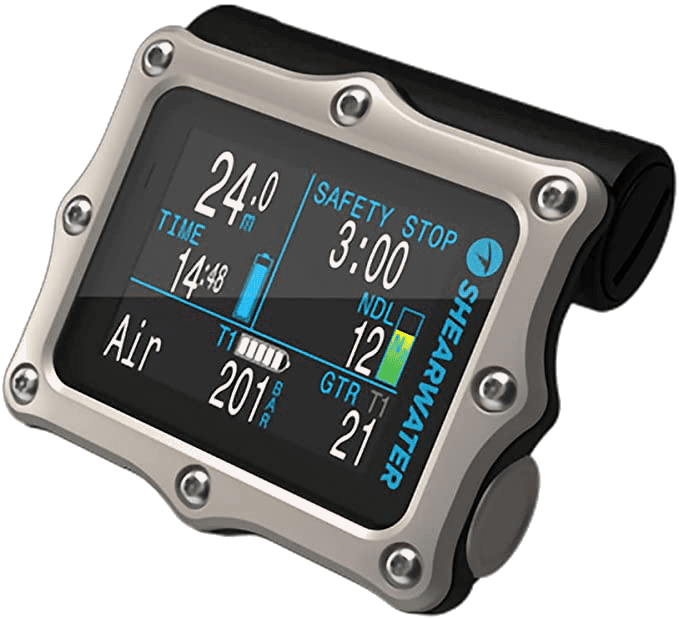
Shearwater remains still, IMHO, the market leader for excellent technical diving computers. As such, the Perdix 2 is their most refined unit to date. It must have been a hard task to improve upon the awesome Perdix.
However, upgrading with a tough titanium bezel, titanium piezo buttons, and impact-resistant aluminosilicate glass screen elevates the all-new Perdix to a higher level.
User-replaceable batteries are popular
I particularly like that Shearwater opts for a user-replaceable AA (or SAFT LS14500) battery. These are easy to obtain in any remote corner of the globe. In turn, that is an advantage for remote expeditions or in locations where the mains power supply for recharging may be unreliable.
What makes Shearwater a very relevant technical diving computer is primarily the flexibility inherent in its firmware.
The Perdix 2 offers air integration (AI) as standard; with the capability to link four transmitters. There is also a dedicated AI sidemount mode for air-integrated transmitters.
Lots of display customization, including GF data
The in-water display allows a high degree of user customization; with excellent options like:
- GF99: the real-time gradient factor %
- @+5: predicted deco 5 minutes in the future
- SurGF: your GF if you immediately surface
Learn how to use these functions in my exclusive ebook:
Become A Shearwater Power User! (eBook)
An Illustrated Guide to Gradient Factors and Advanced Shearwater Computer Settings for safe scuba diving.
42 Pages. Printable PDF format. Fully Illustrated. $9
Become A Shearwater Power User eBook
As featured on the DiveTalk Podcast
Personally, I love this data and use it all the time on my tech dives. It gives the diver much better situational awareness during a technical dive.
Nearly all of the diving parameters are also changeable in water, so you can add or remove gasses; and even change your high gradient factor setting, on-the-fly to react to changing circumstances that may present themselves.
Bühlmann ZH-L16C w/GF is the current tech favorite
The computer ships with Bühlmann ZH-L16C GF and has the option to upgrade to VPM-B. Those options allow the computer to mate very well with the most popular technical dive planning software. Based in Canada, Shearwater has an excellent reputation for customer service. I know several divers who’ve received very rapid replacement units when a fault has occurred.
Firmware is available in multiple languages: English, French, Simplified Chinese, Traditional Chinese, German, Korean, and Japanese. Shearwater provides good dive logging software for PC or Mac, to which dive information is easily transferred via Bluetooth. There are also non-manufacturer dive logging apps for Android or iPhone that sync seamlessly when uploaded.
Product link:
Product manual:
Shearwater Petrel 3
- Algorithm: Bühlmann ZH-L16C with Gradient Factors (VPM-B/GFS optional upgrade)
- PC Link: SMART ready Bluetooth (dual mode 2.1/4.0)
- No. Gasses: 5
- Depth Rating: 140m (guaranteed sensor accuracy) / 290msw (crush depth)
- Screen Type: 2.6” (320×240 pixels) AMOLED Colour High Contrast
- Battery: User-replaceable AA (70 hours in cave mode) or SAFT LS14500 (160 hours in cave mode)
- Mounting: Elasticated straps
- Materials: CNC milled Delrin with titanium bezel and toughened aluminosilicate glass screen
- Compass: 3D digital compass
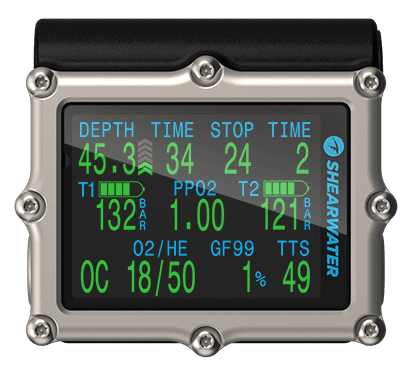
The Petrel 3 is the face-lifted successor to the Petrel 2. It features an all-new titanium bezel and titanium piezo buttons; bringing it into line with the Perdix for ruggedness and good looks. The screen has also been upgraded from plastic to a specially toughened glass material, and the display is improved with AMOLED colour.
The Petrel now has air integration
The Petrel 3 is the first of that range to offer air integration (AI) functionality, with up to four transmitter links possible and a sidemount diving mode.
Constant re-calculation to get you to the surface
What makes the Petrel 3 exceptional for technical divers is that it will constantly re-calculate your decompression even if planned stops are missed. This can make the unit dangerous for untrained divers, as it would permit far less than optimal ascent schedules in response to sloppy diving.
However, it won’t ever abandon you when things go wrong. I think it’s unconscionable that any modern technical diving computer would ‘give up’ on the diver because of a stop violation, but some manufacturers do persist with that liability-driven mentality.
The Petrel was always the rugged option
The Petrel 3 does feel like a ‘brick’ compared to the sleek, lightweight Perdix; although I personally like the reassurance of that rugged ‘milled from a solid block of Delrin plastic’ solidity.
I own a Petrel2 and it has been accidentally catapulted across a dive center to smash onto the concrete floor – and the ‘thunk’ on landing caused immediate relief. A lesser unit would have cracked.
On the negative side, the Petrel 3 misses the option to use integral bungees (my preference). I had to make my own adapters to make bungees work on the Petrel.
Shearwater also offers a fisher connector version of the Petrel 3 for digital integration into CCR.
Product Link:
Product Manual:
Shearwater Petrel 3 OC/CC Manual
Garmin Descent X50i
- Algorithm: Bühlmann ZHL-16c with gradient factors
- PC Link: BLUETOOTH®, ANT+®, Wi-Fi®, Subwave™
- No. Gasses: 11
- Depth Rating: 200m
- Screen Type: 3″ diagnonal, 640 x 360 pixels, RGB
- Battery: Built-in rechargeable with 16-20 hours charge
- Mounting: Elastic nylon with adjustment locking buckles
- Materials: Fiber-reinforced polymer bexel and case. Sapphire crystal screen
- Compass: Digital 3-axis dive compass with adjustable heading, quick change to 90R, 90L and reciprocal.
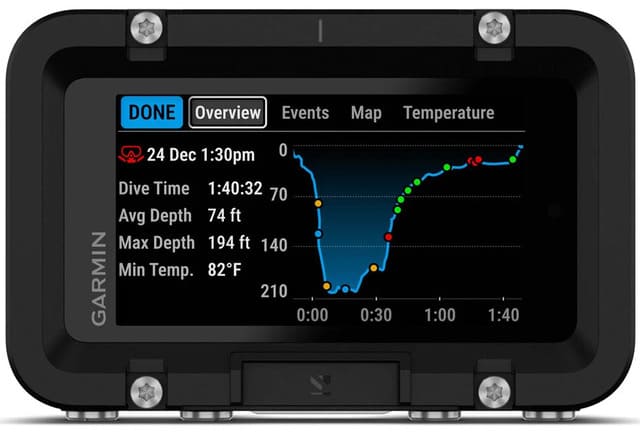
In late 2024, Garmin released its first full-sized diving computer, the Descent X50i. Aimed at technical divers and the premium price market, the computer offers innovative functions like an integral back-up dive-light and SubWave sonar technology diver-to-diver messaging over a 30m/100′ range.
Additionally, the X50i has an ascent profile display which helps divers visualize complex plans to the surface, It has also adopted GF99 and SurGf information displays (as used by Shearwater computers) to enable divers with better decision making for increased safety).
When on land, the Garmin Descent X50i’s dive log provides users with the ability to review comprehensive dive data, monitor their gear, take detailed notes, and share all relevant information via the Garmin Dive app. The log’s real-time depth tracking allows divers to revisit their dive history, analyzing previous dive sites to better understand their characteristics and assess how these locations might influence decompression planning.
For planning future dives, the X50i’s built-in GPS offers navigation to over 4,000 preloaded dive sites across the globe. Additionally, users can enrich their dive-site information by adding custom points of interest through DiveView maps. These advanced maps include bathymetric depth contours, providing a more detailed view of underwater terrain, and work in conjunction with the preloaded TopoActive maps.
On the surface, the GPS functionality is also valuable for tracking both dive-site entry and exit points, ensuring a seamless and efficient dive experience. Additionally, the X50i can access tide data when paired with a compatible Android or Apple smartphone.
Amazon Product Link:
Manufacturer Product Link:
Product Manual:
Garmin Descent X50i Owners Manual
Best technical diving computer – innovative function
O’Dive Odyssey Technical
- Algorithm: Bühlmann ZH-L16 w/O’Dive IQ Simulation GF
- PC Link: Bluetooth
- No. Gasses: 8
- Depth Rating: 125m
- Screen Type: 2.4″ (320×240 pixels) high-definition TFT OLED
- Battery: User-replaceable AA
- Mounting: unknown
- Materials: unknown *looks like injection-moulded Delrin
- Compass: Digital
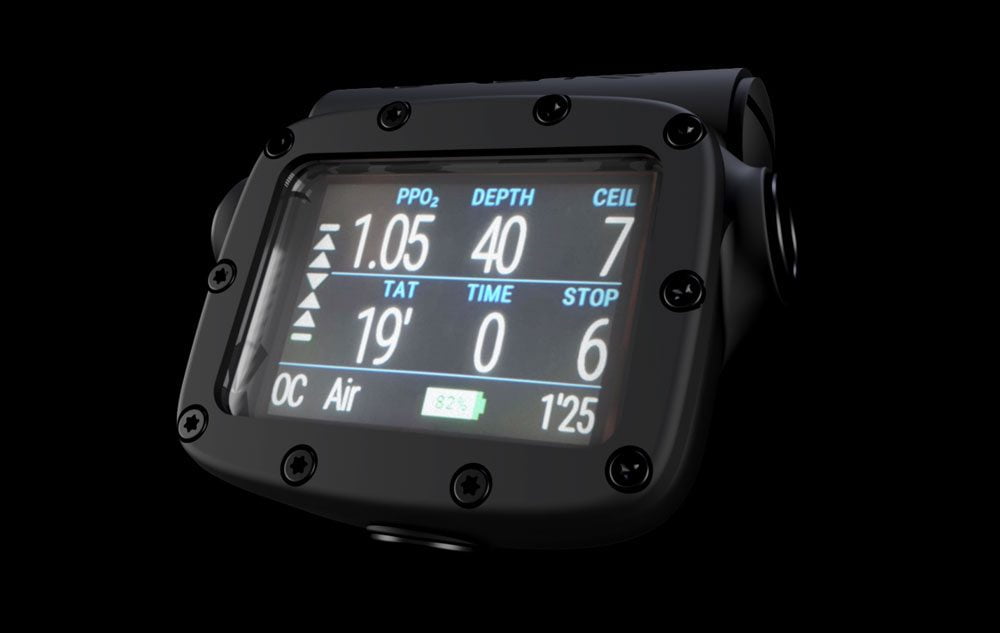
Detailed information and specifications about the Odyssey Technical are sparse on the O’Dive website.
However, this computer is causing a buzz in the technical diving community due to its decompression control that links to the excellent O’Dive Doppler Bubble Sensor.
As I understand it, divers determine their post-dive bubble score and the Odyssey computer utilizes the Doppler sensor’s data to custom tweak optimal gradient factor settings over time. That functionality is truly field-leading and has the potential to make technical diving a much safer pursuit.
At the time of writing, there seem to be production/ release issues with the Odyssey; although I’d expect to see it available on the market in early 2023.
Product Link:
Product Manual: no link found
Divesoft Freedom Full Trimix
- Algorithm: Bühlmann ZH-L16 w/GF
- PC Link: USB
- No. Gasses: 9 (unlock/upgrade from Bottom Timer to Air, Extended Range, or Trimix)
- Depth Rating: 300m operational depth (no guaranteed sensor accuracy depth stated) (crush depth 600m/2000ft)
- Screen Type: Full color (2.4″ vs 2.2″) TFT OLED display
- Battery: USB rechargeable Li-Ion (no details given of battery life dive mode)(5 hours recharge)
- Mounting: Elasticated Straps or Integrated Bungee
- Materials: Aluminum housing
- Compass: None
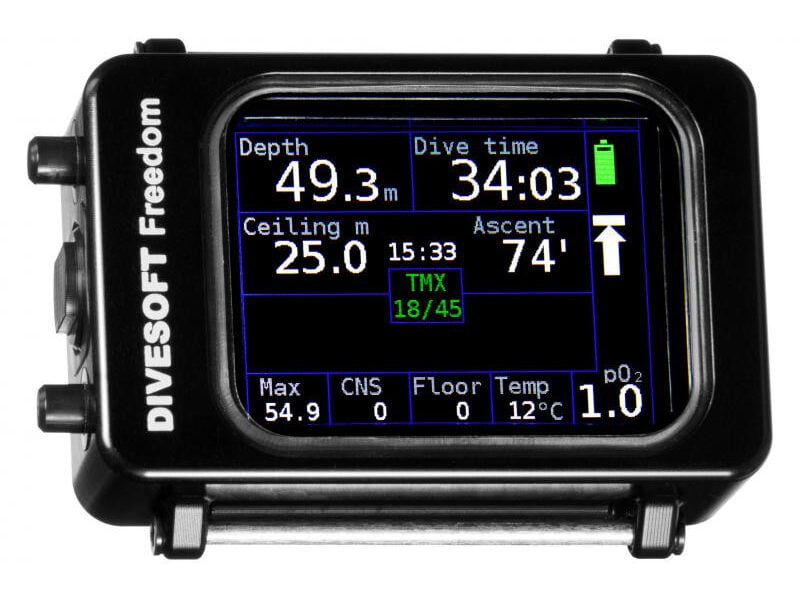
The Divesoft Freedom is available with varied firmware options; bottom timer, nitrox (1 gas >40%), advanced nitrox (3 gas >100%), and trimix (9 gas w/helium). The four-button long/short/simultaneous-press user interface seems a little complicated to use, but I’ve heard it’s quite intuitive to learn.
The computer has an add-on extra O2 analyzer function and can link to CCR (it’s used as a standard with the (Liberty CCR). It is even loaded with a suite of basic games to help make your decompression stops pass quickly.
Sadly, the website/manual is unclear on the expected battery duration on dives/standby. The Li-On battery charges via USB in 5 hours.
With that large OLED screen, multiple functions, and vibrating alarms, I would be concerned that battery life might be noticeably less than other technical diving computers on the market.
Product Link:
Product Manual:
Divesoft Freedom Full Trimix manual
Heinrichs Weikamp OSTC 4
- Algorithm: Bühlmann ZH-L16+GF and VPM-B (switchable during the dive)
- PC Link: Bluetooth
- No. Gasses: 5
- Depth Rating: 200m
- Screen Type: 3.2″ (800 x 480 pixel) IPS LCD monitor
- Battery: Wireless inductive Qi charging Li-Ion (40 hours in dive mode)(2 years stand-by mode)
- Mounting: Integrated Bungee
- Materials: Aluminum housing with Perlucor ceramic screen
- Compass: 3D digital compass

The OSTC4 is the Heinrichs Weikamp flagship model. It is uncompromising and innovative in the technology and features supplied. A high purchase cost ($1355) reflects high-end features such as; inductive charging and dual-algorithm processing. It also has the most beautiful high-resolution screen on the market.
The computer features a powerful 32-Bit dual-core processor. This offers it sufficient computing power to run BOTH the Bühlmann ZH-L16+GF and VPM-B algorithms simultaneously during dives. You can switch and/or compare whenever you want. The Li-Ion inductive rechargeable battery is user-changeable, which saves a lot of hassle when battery replacement intervals come.
I’d like to see some more diver information options on this computer; like the @+5, GF99, and GFSurf displays that Shearwater includes – as these can significantly aid the diver’s awareness and decision-making loops.
Tactical in-water information display is one area where most tech computer manufacturers need to get more creative. After all, the intelligent information display is the main purpose of the computer; and what serious technical divers look for.
With the biggest, clearest display currently on the market, it enables a lot of valuable information to be displayed on a single, main screen during dives Although, the text can still be a little petite for divers with weaker eyesight. It has a wet connector for use with CCR and there is an option to get the hwHUD system.
Product Link:
Product Manual:
Heinrichs Weikamp OSTC 4 manual
TDC-3 MultiDeco
- Algorithm: Bühlmann ZH-L16C w/GF, VPM-B, VPM-B/E (Extreme), VPM-B w/GFS (Gradient Factor Surface), and VPM-FBO (Fast Bail Out)
- PC Link: WiFi (direct to internet cloud)
- No. Gasses: 10
- Depth Rating: 150m
- Screen Type: 2.2″ (320 x 240 pixel) Color TFT LCD
- Battery: Dual (redundant) user-replaceable SAFT lithium 3.6v or 1.5v alkaline AA
- Mounting: 3mm bungee straps (optional straps)
- Materials: All metal alloy machined body, scratch-resistant screen
- Compass: 3D digital compass

The TDC-3 was released in 2018 by the creator of MultiDeco software, Ross Hemmingway. Not surprisingly, this computer features the most complete range of decompression algorithm options on the market – everything, in fact, that you’d find on the MultiDeco platform.
Dual redundant batteries
It has several unique features and innovations that deserve special consideration. Firstly, it uses dual/redundant user-replaceable batteries – not only giving a very long battery life but also minimizing any risk of battery failure during a dive. The computer menus are also accessed via a dual system, You can either use the two main piezo buttons on the sides or a 4-way tap method on the housing itself.
Lots of pre-designated ascent options
Given the designer’s expertise in dive planning software and deco algorithm implementation, the computer has some novel options for pre-designating up to four (4) custom pre-set ascent and/or bail-out plans.
The computer doesn’t have Bluetooth but instead incorporates full WiFi functionality. This means you can connect it directly to the internet for updates or dive logging via the Cloud interface. Logs can be downloaded or viewed on any device using HTML5 browser software.
The unit is low profile, even with the extra battery swallowed within, and the display is clean and easy to read. I particularly liked that it gives both ascent and descent rates in a full meters/feet per minute format – I wish more computers would adopt that.
Product Link:
TDC3 Technical Diving Computer
Product Manual:
Ratio iXM3-2 Tech+
- Algorithm: Bühlmann ZH-L16C w/GF and VPM-B
- PC Link: USB and Bluetooth
- No. Gasses: 10
- Depth Rating: 300m / 984ft (crush depth / 130m/426ft sensor precision
- Screen Type: 2.8″ (144 dpi / 320×240 pixel) QVGA IPS
- Battery: USB rechargeable Li-Ion (20-50 hours in dive mode)(4-5 hours recharge)
- Mounting: elasticated straps
- Materials: POM C (Acetal Copolymer molded resin plastic) and Mackrolon screen
- Compass: 3D digital compass

The iX3M-2 Tech+ is the flagship of Ratio’s “Pro” technical computer range, and is programmed for full trimix capability. It comes loaded with features.
The iX3M-2 Tech+ features
The iX3M-2 Tech+ has options to download additional integrated apps like:
- Magnetometer
- Luxmeter
- Altimeter
- Moon calendar
- Chronometer
- Pitch/roll display
- Weather forecast
- Barometer
- USB plug-in O2 analyser (optional)
- Integral gas-blending software installed.
The unit is wireless air integration and illuminating colour-coded transmitters can be purchased. The illuminating transmitter LEDs are also color-coded to warn of gas pressure:
- Green = 100+ bar
- Yellow = 50-100 bar
- Red = 0-50 bar
Some divers may find this useful, but I can’t help thinking all those lights would make you sparkle like the Las Vegas strip on a dark dive.
If you want the integrated GNSS (GPS, GLONASS, Beidou, Quasi-Zenith) system, it is available on the separate iX3M [Gps] Tech+ model.
Other iX3M-2 models
Ratio also offers more economical models, restricted for nitrox or normoxic trimix diving only:
- iX3m-2 [PRO] Easy – 2 gasses (air/nitrox), 6x Bühlmann ZHL-16B pre-set (not user-definable)
- iX3m-2 [PRO] Deep – 3 mixes (air/nitrox/normoxic trimix), 6x Bühlmann ZHL-16B pre-sets (not user-definable) and 6x VPM-B pre-sets.
Recreational divers can set their own preferences for deep stops (standard or Pyle method) and can manually input/designate what method of safety stops they want to complete. The computer also features visual, audible, and vibration alarms.
Product Link:
Product Manual:
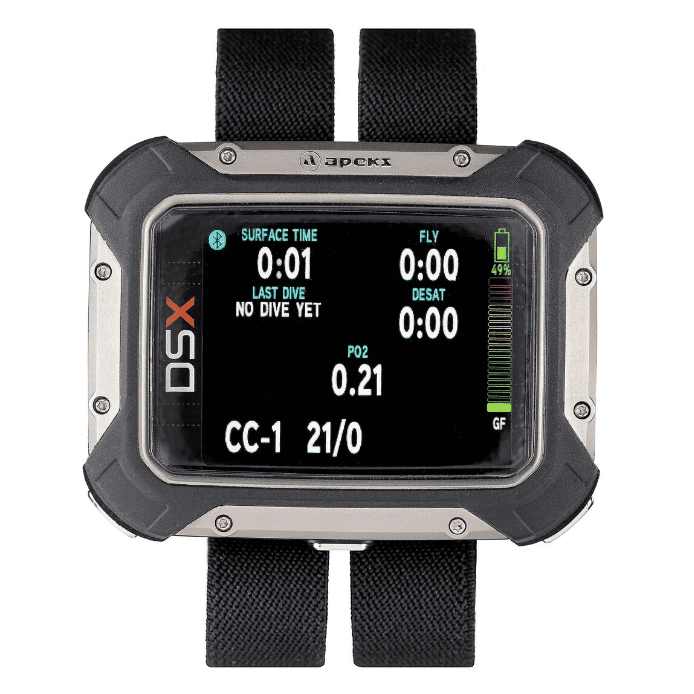
Apeks DSX Technical Diving Computer
- Algorithm: BühlmannZH-L16C with gradient factors, and optional sports deep stops
- PC Link: Bluetooth 5.0
- No. Gasses: 6
- Depth Rating: 130m
- Screen Type: 2.4” Color TFT LCD
- Battery: Rechargeable Li-Ion with fast cable and inductive charging mat
- Mounting: Elastic buckle straps or bungees
- Materials: Plastic body with titanium bezel
- Compass: 3D digital compass
Newer to the market, the Apeks DSX offers a wide range of functionality. It comes with an oxygen analyzer which links readings to the dive computer when setting up for dives. It is capable of linking up to six air integration (AI) transmitters and there is a dedicated sidemount diving mode available. The unit has GPS technology and will mark your descent and ascent surface locations when you are diving.
Product Link: Apeks DSX Technical Diving Computer
Product Manual: Apeks DSX Manual
Heinrichs Weikamp OSTC PLUS
- Algorithm: Bühlmann ZH-L16C with optional gradient factors
- PC Link: Bluetooth Smart Ready (2.0 and 4.0)
- No. Gasses: Sport edition: 3 | Tech edition: 5
- Depth Rating: 120m
- Screen Type: 2.4″ (320 x 240 pixel) IPS LCD monitor
- Battery: Pad Rechargeable Li-Ion (2-hour charge) or user-replaceable AA
- Mounting: Integrated Bungee
- Materials: Aluminum housing with scratch-resistant borosilicate-glass panel
- Compass: 3D digital compass
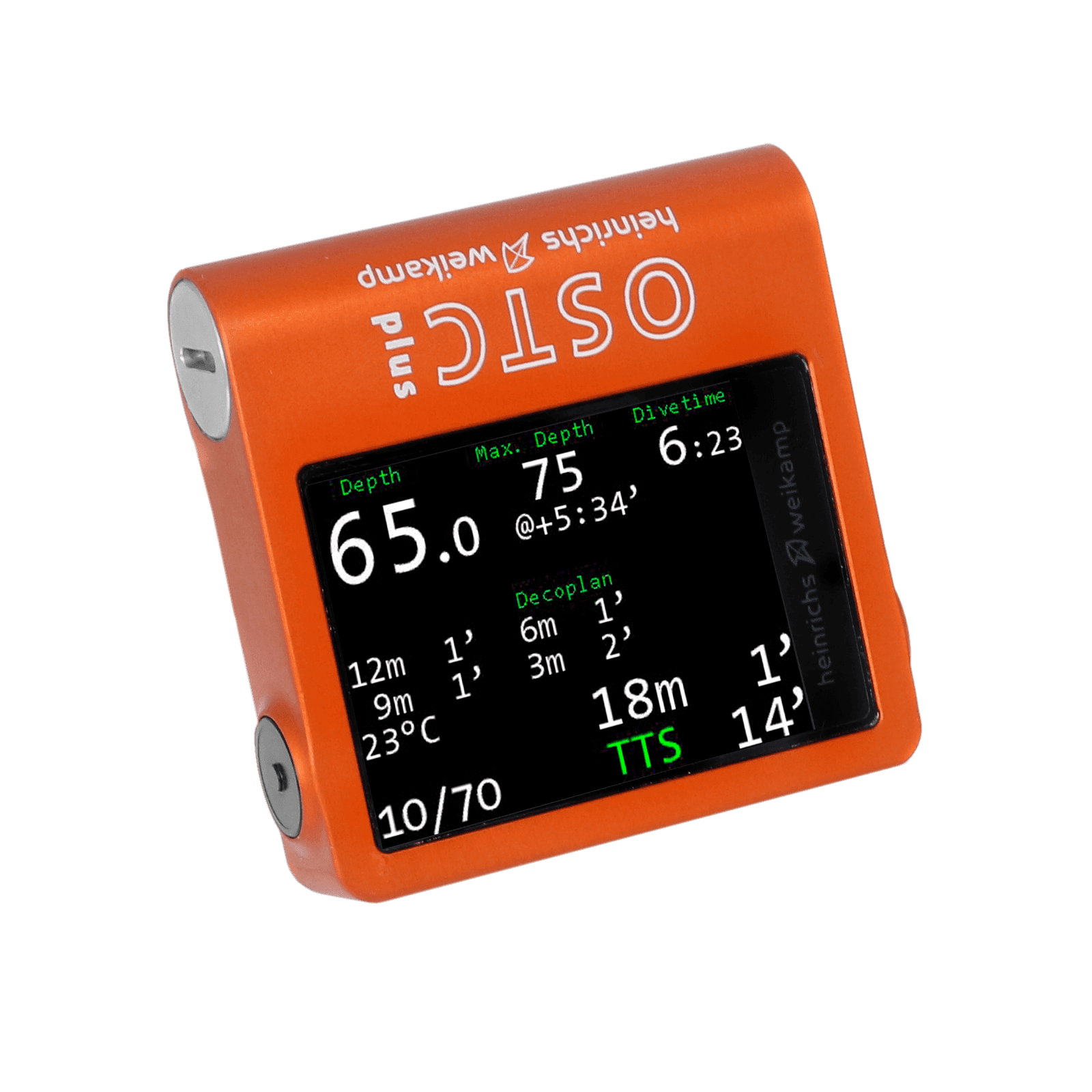
The latest offering from Heinrichs Weikamp is compact and colorful. It offers a more economical alternative to the OSTC4, at just over half the cost (Sport:$765/Tech: $900) of the flagship model. The OSTC range is well-known for outstanding build quality, well-implemented firmware, and great customer service. This new model follows that tradition.
Heinrichs Weikamp OSTC PLUS firmware formats
The OSTC PLUS is available in two firmware formats; Sport and Technical. The Sport firmware is limited to three gasses (>100% O2), whereas the Technical version has five gasses, including trimix. Users buying the Sport firmware can upgrade, at extra cost, at a later date.
The milled aluminum build is of very high quality and provides the unit with a high level of streamlined ruggedness. The anodised aluminium housing is available in a choice of seven colours; black, orange, green, gold, blue, purple, and silver/grey.
Heinrichs Weikamp doesn’t have the big distribution network that other, larger, computer manufacturers have; so you tend to see less of them in use outside of Europe.
OSTC PLUS battery incident
Note: The OSTC PLUS did make the news in January 2019, as a display model exploded at a dive show, causing injuries. In a statement released by Heinrichs Weikamp, the explosion was caused by incorrectly inserting a non-rechargeable SAFT 3.6v battery. The unit incorrectly identified this as a rechargeable Li-Ion battery and, when placed on the charging dock, proceeded to charge the battery. After several hours, that battery exploded within the unit. There has been a firmware fix to prevent this problem reoccurring and Heinrichs Weikamp has stated that only 1.5v Alkaline non-rechargeable or Li-Ion 3.6v rechargeable batteries should be used.
Product Link:
Product Manual: Not Yet Available
Suunto Eon Steel
- Algorithm: Suunto Fused™ RGBM upgradeable to Bühlmann ZH-L16C with Gradient Factors
- PC Link: USB
- No. Gasses: 10
- Depth Rating: 150m operational depth (no guaranteed sensor accuracy or crush depth stated)
- Screen Type: LCD TFT Display (320 x 240) with LED backlight
- Battery: Rechargeable Li-Ion battery (20-40 hours)(30 days in standby mode)
- Mounting: Elastomer strap or optional bungee
- Materials: Brushed Stainless Steel bezel, composite body, and Xensation™ glass display
- Compass: 3-Axis, Tilt Compass

Update finally allows Bühlmann ZH-L16C
The Suunto Eon Steel was on my ‘not recommended’ list until March 2022, when it released an upgrade option to install Bühlmann ZH-L16C. As a technical instructor, I was never comfortable with the secretive and unpredictable Suunto Fused RGBM proprietary model.
The update needs to be conducted by authorized Suunto dealers, rather than a simple firmware update on the internet like most decent dive computers have. I am assuming that Eon Steels coming out of the factory will have that update pre-installed as standard.
The Suunto Eon Steel does have air integration (AI), but unlike its competitors has not developed a sidemount diving mode where two cylinders can be monitored simultaneously on the screen.
So many gas mix options
The Eon Steel does boast 10 gas mixes. I am pondering who needs 10 gas mixes for dives down to 150m.
It reminds me of that scene from the comedy movie “There’s Something About Mary”:
Hitchhiker: You heard of this thing, the 8-Minute Abs?
Ted: Yeah, sure, 8-Minute Abs. Yeah, the exercise video.
Hitchhiker: Yeah, this is going to blow that right out of the water. Listen to this: 7… Minute… Abs.
Ted: Right. Yes. OK, alright. I see where you’re going.
Hitchhiker: Think about it. You walk into a video store, you see 8-Minute Abs sittin’ there, there’s 7-Minute Abs right beside it. Which one are you gonna pick, man?
Ted: I would go for the 7.
Hitchhiker: Bingo, man, bingo. 7-Minute Abs. And we guarantee just as good a workout as the 8-minute folk.
Well…. there you go folks…. “10 Gas Mixes“…
Suunto software is also chock full of ‘obstructive safety protocols that have absolutely no part in technical diving. They may be useful for keeping unaware or incautious recreational divers safe, but those protocols pose real issues for technical divers.
Tech computers should never lock you out
An example of this is the Suunto “Algorithm Lock”, whereby the computer automatically shuts you out for 48 hours if you violate a decompression ceiling for more than 3 minutes. The screen will display only an ‘ERROR’ message.
If, as a technical diver, you were in a position where you had to ascend beyond a designated stop (I can think of a few examples of those), the computer algorithm would simply abandon you. Compare that to other tech computers, which would re-calculate the ‘next best’ decompression schedule to get you safely to the surface.
Modern technical diving computers should never abandon the diver in-water.
Adding a safety stop to technical dives
Suunto computers always add a safety stop. This means that when in decompression, the TTS (time-to-surface) always reads 3 minutes longer than is actually demanded by the algorithm. It’s annoying… and I’ve seen it confuse more than a few novice technical divers. Do I have 5 minutes of decompression to complete or 8 minutes…. why is this unclear?
The Suunto Eon Steel allows a choice between 4 dive screens. It cannot be fully customized like, for instance, a Shearwater Perdix user can select which information is displayed, and where on the screen they want it.
Fully customizable, except it is not
Suunto uses the term “full customization’ throughout their advertisements and product literature for the Eon Steel. I find it one of the least customizable technical computers on the market.
Overall, I feel that the Suunto Eon Steel markets itself mostly to recreational divers who want a computer that “appears technical” but actually operates like a limiting recreational diving computer.
More of a faux-tech computer
It’s almost “faux-tech’; a computer that looks great on recreational dives, but falls very short on technical dives.
A modern technical diving computer simply cannot give you an “ERROR” screen if you are forced to adopt an ascent profile that varies from the ideal. Nor should it amend the decompression algorithm based on “diving habits” and “dive violations” once decompression and gas plans have been committed to by the technical diver.
Product Link:
Product Manual:
Suunto Eon Steel Manual
Dive Computer EU
- Algorithm: Bühlmann ZH-L16C with Gradient Factors
- PC Link: Bluetooth
- No. Gasses: 10
- Depth Rating: 130m (pressure sensor accuracy)
- Screen Type: TFT LED Screen (320 x 240 pixel)
- Battery: Replaceable AA battery
- Mounting: 5mm Bungee mount
- Materials: CNC-milled Polyacetal (Delrin, POM) and stainless steel 316L
- Compass: 3D digital compass

If you are confused, the name of this computer is the “divecomputer.eu”. Kinda weird because that’s just the website address. In the USA and Canada it is sold and branded at the Deep6 “Triton’s Abacus”.
Manufactured in Europe, this is a pretty rudimentary but functional tech computer. It runs the modern-standard Bühlmann ZHL-16C algorithm with Gradient Factor adjustments.
It has six different operating modes, catering for every type of diving you might want to do:
- Apnea Mode
- Extended Gauge Mode (with 4 stopwatches)
- Open Circuit Recreational
- Open Circuit Trimix
- Closed Circuit – Fixed Setpoint
- Pure Buhlmann – variable ceiling
At $600 fully loaded to trimix specifications, via Deep6, it represents one of the most economical full tech computers on the market.
Product Link (Global):
Product Link (US and Canada):
Product Manual:
Underwater Technologies AV1
- Algorithm: Bühlmann ZH-L16C w/GF
- PC Link: USB
- No. Gasses: 8
- Depth Rating: 200m tested depth range (130m sensor accuracy depth)
- Screen Type: Full color 2.4″ (320 x 240) TFT OLED display
- Battery: USB rechargeable Li-Ion (10-hour in dive mode)(5 hours recharge)
- Mounting: Elasticated Straps or Integrated Bungee
- Materials: Delrin housing and polycarbonate screen
- Compass: 3D Digital Compass
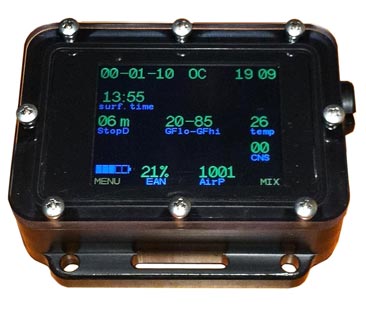
The Russian-made AV1 is similar in size, display, and basic functions to the Shearwater Petrel2. It is available with a Fischer connector (the AV1F version) and custom heads are manufactured for use with the Inspiration Classic/Vision and Poseidon MKIV CCRs.
However, unlike the Petrel2, the AV1 uses a USB rechargeable Li-Ion battery which necessitates removing/replacing a waterproof cap during each charging cycle. This dry connection does present a risk of flooding.
One nice feature on the AV1 is that the diver can access the full deco plan on a separate screen. This allows a little more forward planning than only having a TTS and current stop information available. It comes pre-installed with the game ‘Python’ to make decompression stops pass a little quicker.
The AV1 doesn’t have additional diver information like GF99, @+5, or real-time tissue saturation graphs. The majority of additional software functions are aimed at CCR divers, for whom this unit seems primarily focused.
Product Link:
Product Manual:
Underwater Technologies AV1 manual
Poseidon Mk28
- Algorithm: DCAP and Bühlmann ZH-L16 w/GF
- PC Link: WiFi Access Point, Bluetooth, IrDA (surface only)
- No. Gasses: 8
- Depth Rating: 200m
- Screen Type: 2.8” TFT QVGA LCD (pixel info not given)
- Battery: Integral USB rechargeable (no details given of battery life in dive mode or charging time)
- Mounting: Integrated Bungee
- Materials: Not listed on website
- Compass: Digital
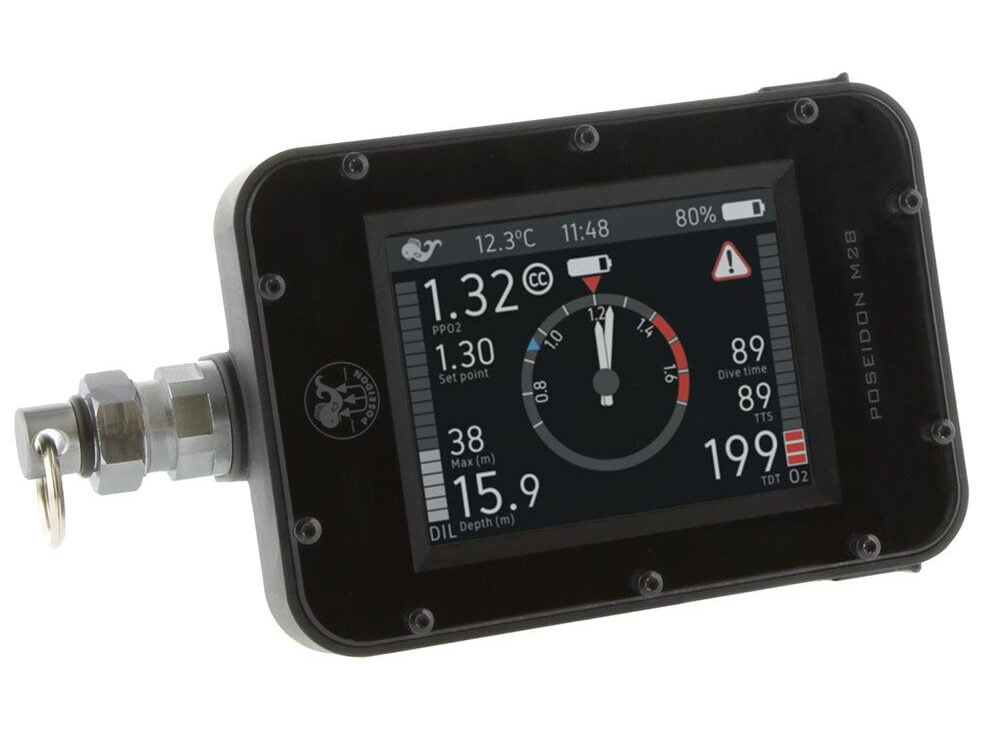
Why so shady on the specifications?
Firstly, Poseidon… if you are listening…. when you charge a whopping $2000 for an instrument, please do bother to put all pertinent technical information on your website and in your manual. Details specification on ‘small’ details like materials, screen resolution, battery life, charge time and available gas mixes. This information does make a difference to prospective purchasers. We shouldn’t have to read to page 39 of the user manual just to find that it allows eight gas mixes.
The Poseidon Mk28 is first and foremost designed as a CCR computer, in particular for integration with Poseidon’s own range of rebreathers. Open Circuit use seems an afterthought, although the computer is fully functional through to OC Trimix.
Lots of CCR connectivity options
There is a range of connecting cables as optional extras for configuring with Poseidon’s Se7en CCR, a CAN Bus connection, cables for the Poseidon Solid-State O2 Sensor or CPOD to allow use with any other brand of CCR.
It is claimed as “the world’s most powerful dive computer“, but I could find no specific details on Poseidon’s website to illuminate why that claim is made. It is probably the world’s most expensive technical computer.
The Mk28 includes a built-in GPS and full world map software. However, there are reports that the GPS system is exceptionally slow to gain satellite data and that significantly detracts from its usability.
I don’t see anything to justify the huge price tag of this computer, other than its functionality with Poseidon’s own rebreathers.
Product Link:
Product Manual:
The Best Technical Diving Computer – Watch Sized
For more detailed review of watch-sized dive computers, see my full report here: What are the best watch-sized dive computers 2023?
*best technical diving computer – watch sized*
Shearwater Teric
- Algorithm: Bühlmann ZH-L16 with Gradient Factors
- PC Link: Bluetooth Smart LE
- No. Gasses: 5
- Depth Rating: 200m
- Screen Type: 1.39″(400 x 400 pixel) Full Colour AMOLED
- Battery: Rechargeable docking Li-ion Battery; Dive Mode 30+ hours / Watch Mode 50+ hours
- Mounting: watch-style
- Materials: Ballistic nylon polymer case and 316 Stainless bezel/buttons with sapphire crystal screen
- Compass: 3D digital compass
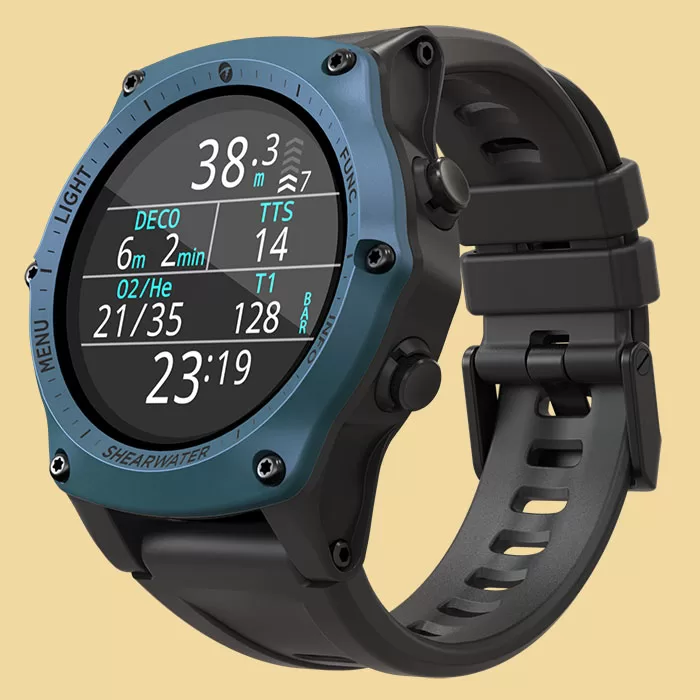
Shearwater energized the market with its release of the Teric in 2018. This watch-sized technical computer squeezes in all of the functionality and firmware that you’d be accustomed to seeing on their full-size models.
It has OC recreational, OC technical, CCR, gauge, and freediving modes. You can connect up to two (2) AI transmitters for wireless gas tracking and the screen display is vibrant and easy to view even in glare conditions.
Whilst the Teric doesn’t have the vast suite of sports and outdoors features offered by its competitor, the Descent Mk1 (see below), it is more functional as a dedicated technical diving computer – especially in regards to the data options like; GF99, GFSurf, tissue compartment graphs etc.
Product Link:
Product Manual:
Best technical diving computer – dry land functionality
Garmin Descent 51mm Mk3i
- Algorithm: Bühlmann ZH-L16c with Gradient Factors
- PC Link: Bluetooth® Smart, ANT+®, Wi-Fi®
- No. Gasses: 11 + CCR mode
- Air Integration: 8 transmitters
- Depth Rating: 200m
- Screen Type: 1.4” (454 x 454 pixels) AMOLED colour
- Battery: Rechargeable Li-Ion with proprietary clip charger: 25 days in smartwatch mode, 66 hours in dive mode (40 hours for Mk2i using transmitters), and 55 hours in GPS mode.
- Strap: 22mm QUICKFIT™ Silicone
- Materials: Fiber-reinforced polymer case with titanium rear cover and diamond-like carbon (DLC) coated titanium and scratch-resistant sapphire crystal screen
- Compass: 3D digital compass
- Price: $1599 (51mm Mk3i)
The Garmin Descent Mk3i (51mm) is a full-function trimix computer, with added functionality as a full smartphone compatible (with smart notifications and controls) outdoors, fitness, and sports watch.
Whilst the Teric is a dedicated technical diving computer with a lot of the excellent diving functionality you’d see in Shearwater’s full-size devices, the Garmin Descent Mk3i is much more of an all-round, watch-sized diving computer. The Garmin will appeal to those who also want the features of both a modern smart-watch and a highly capable sports/outdoors instrument; in addition to being an excellent dive instrument.
Garmin released two new models of the Descent Mk3 in November 2023: the Mk3 and Mk3i (air integration).
The Garmin Descent Mk3i model is available in two sizes, a smaller 43mm or a large 51mm. The larger size watch offers more functionality, a significantly larger screen, and much longer battery life. Additionally, the 51mm Mk3 has a built-in LED light, with a strobe function, for emergencies.
In addition to all of the functionality offered on the older Mk2 (see below), the new 51mm Mk3i has a larger screen with much higher resolution and allows up to 8x T2 transmitters to be connected. This can allow inter-diver monitoring and can also enable preset diver-to-diver messaging (Subwave Sonar Messaging).
Technical divers may appreciate the improved depth rating of the Mk3, with 200m of pressure resistance, rather than the 100m of the Mk2.
New software apps on the M3i include a ‘Dive Readiness Tool‘ which monitors your biodata pre-diving to suggest DCS susceptibility, and ‘DiveView Maps‘ showing depth contours for over 4000 dive sites around the world.
In dive mode, it offers forty customizable alarms, has three conservatism settings plus custom settings for gradient factors, and has several safety stop options, including custom stop settings. It has a CCR diving mode.
It features a vast array of sensors, including; GPS, GLONASS, constant heart rate monitor, blood oxygen (spO2) sensor, barometric altimeter, compass, gyroscope, accelerometer, and thermometer.
Descent Mk3i: Multisport operating modes
These allow specific multisport operating modes, which can be linked to the internet via a smartphone, for swimming, cycling, golf, fitness tracking, running, and outdoors (hiking/climbing, mountain biking, skiing, snowboarding, rowing, jumpmaster, and tactical).
You can download digital maps onto the watch, for use with the abovementioned modes, and record the entry and end points of your dive using GPS/GLOSNASS/Galileo satellite systems.
It has a music player feature (2000 songs storage); you can link Bluetooth headphones and connect to streaming apps, like Spotify. The Descent Mk3i is also smartphone compatible with Android and iPhone.
Smaller 43mm versions of the Garmin Descent Mk3
There are two models available in the 43mm size; with air-integration (Mk3i) and without (Mk3).
The Garmin Descent 43mm Mk3 is slightly smaller than the older Mk2 (43x43x14.15mm versus 52x52x17.8mm), which may be desirable for smaller divers. However, it also has a smaller screen size (1.2″ vs 1.4″) which some may find less easy to read.
The disadvantage of a smaller screen size is somewhat balanced by a significantly higher resolution compared to the Mk2 (390x390px versus 280x280px).
One of the biggest drawbacks of the 43mm version of the Mk3 is its shorter battery life compared to the 51mm model. You will need to recharge far more frequently. Additionally, the small version of the Descent Mk3 does not feature an in-built LED emergency light.
Other Garmin Descent Mk2 versions
Mk2S version: The Mk2s is smaller in size; 43mm compared to the other options which have a 52mm case size. It has a smaller screen diameter of 1.2″ (240 x 240 pixels) and weighs just over 100 grams/2oz (silicone band: 60 g/ case 41g). It is available in three color options.
Mk2i version: The Mk2i has air integration (AI) technology and links to Garmin’s T1 gas transmitters; this tracks your gas consumption and provides information on the remaining time available. It has the functionality to pair with up to five different transmitters, which are sold separately. The watch has a Diamond-like Carbon (DLC) coated titanium bezel and an option for a titanium metal strap. It weighs a silicone band: 99.6 g with a silicon band and 160.3g with a titanium band.
Product Link:
2. Descent Mk2S – small size option
3. Descent Mk2i – air integration/titanium
Ratio iDive Color Tech+
- Algorithm: Bühlmann ZH-L16B w/GF and VPM-B
- PC Link: USB
- No. Gasses: 10
- Depth Rating: 220mt / 721ft
- Screen Type: TFT LED w/IPS, 1.3″ (240×240 pixel) 261 ppi
- Battery: USB rechargeable Li-Ion (25 hours in dive mode)
- Mounting: Polymer straps
- Materials: Sapphire Crystal screen with Stainless steel bezel and case.
- Compass: 3D digital compass
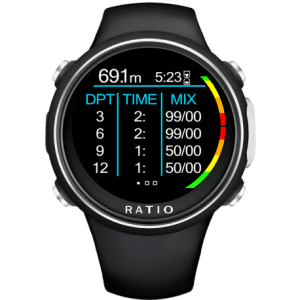
The iDive Color Tech+ is the new 2019 flagship of Ratio’s watch-sized computer range. It is programmed for full trimix capability and comes with many of the features you’d find on their full-sized iX3M range.
The top-of-the-range Color Tech+ comes with a sapphire crystal screen. This material is second only to diamond with respect to hardness and scratch-resistance and improves the depth rating of the Tech+ to 220m compared to the Easy and Deep variants which have mineral glass screens.
As with the iX3M, the iDive Color Tech+ opts for the Bühlmann ZHL-16B algorithm, which is an unusual decision that I cannot explain a reason for.
Lots of Ratio computer gadgets
You’ll find it has all the standard Ratio gadgets:
- Magnetometer
- Luxmeter
- Altimeter
- Moon calendar
- Chronometer
- Pitch/roll display
- Weather forecast
- Barometer
- USB plug-in O2 analyser (optional)
- Integral gas-blending software installed.
Flashy LED transmitters
The unit is wireless air integration and illuminating colour-coded transmitters can be purchased. The illuminating transmitter LEDs are also color-coded to warn of gas pressure;
- Green = 100+ bar
- Yellow = 50-100 bar
- Red = 0-50 bar.
The tech community generally hasn’t adopted air integration yet, so I doubt this would be a valuable functionality for many buying the Color Tech+. Also, for cave and wreck divers, all those sparkly transmitter LEDs are liable to be distracting in dark environments.
Other Ratio iDive models
Ratio also offers more economical models, restricted for nitrox or normoxic trimix diving only:
- iDive Color Easy – 2 gasses (air/nitrox), 6x Bühlmann ZHL-16B pre-set (not user-definable)
- iDive Color Deep – 3 mixes (air/nitrox/normoxic trimix), 6x Bühlmann ZHL-16B pre-sets (not user-definable) and 6x VPM-B pre-sets.
Recreational divers can set their preferences for deep stops (standard or Pyle method) and manually input/designate what method of safety stops they want to complete.
Product Link:
Product Manual:
NOT the best technical diving computer (I don’t recommend these)
Scubapro G2
- Algorithm: Uwatec ZHL-16 ADT MB
- PC Link: USB and Bluetooth
- No. Gasses: 8
- Depth Rating: 120m / 394ft
- Screen Type: TFT (Thin-Film Transistor) LCD 2.2in” (320×240 pixel)
- Battery: USB rechargeable Li-Ion battery (50 hours)
- Mounting: Integrated bungee mounts or Elastomer strap
- Materials: Fiberglass-reinforced thermoplastic case with TR 55 transparent thermoplastic screen
- Compass: Digital Compass
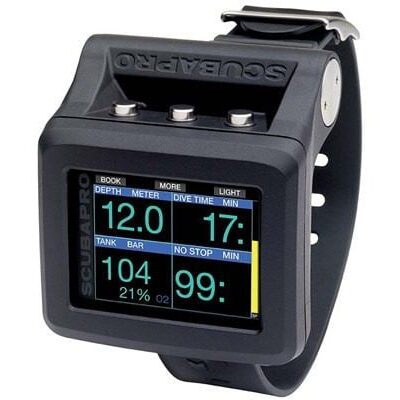
The Scubapro G2 doesn’t make my list because they’ve opted for a proprietary in-house iteration of the Bühlmann ZHL-16 algorithm – the Uwatec ZHL-16 ADT MB (Adaptive Micro Bubble).
Take something that works and then mess with it
The creation of ZHL-16 ADT MB seems simply to empower a more expensive retail package that includes a heart rate monitor (HRM) and facilitates arbitrary deep-stop (PDIS) functionality that’s taken a hammering in contemporary scientific studies:
See: US Navy Experimental Dive Unit (NEDU) technical report 2011-06: “Redistribution of decompression stop time from shallow to deep stops increases incidence of decompression sickness in air decompression dives“. Doolette, DJ; Gerth, WA; Gault, KA. (2011)
The ‘trend’ for deep-stop algorithms took a sudden U-turn when the 2011 NEDU study was released, and Scubapro/Uwatec seem a little slow keeping pace with the latest developments.
Instead of using a dedicated bubble-model (dual-phase) algorithm, like VPM-B, they opted to bastardize a gas diffusion model into providing deep-stop results. Being a proprietary in-house project, nobody outside of Uwatec knows exactly how they achieved that – which isn’t reassuring for technical divers.
No science to support heart-rate adaptive algorithms
To date, there is no scientifically studied validation for heart-rate adaptive algorithms, which means that UWATEC has applied variable modifications to the inert gas uptake and elimination rates based on zero published or proven rationale.
“To my knowledge, there is no laboratory data to indicate how much, if any, adjustment should be made for nitrogen uptake and elimination in these situations. […] No doubt, the [ZHL-16 ADT MB] programmer simply entered some modifying factor into the algorithm and presents this as the gospel truth. This is nice for marketing but the modifications are guesswork, as far as I am aware. Computer makers do not perform laboratory research for their devices”.
Michael R. Powell (Dr Deco), M.S., Ph.D, NASA (retired)
In short, it’s a gimmick. Scubapro modified a well-proven base algorithm to implement unproven concepts; chiefly to appeal to divers who may be under a misguided impression that deep stops and heart rate are scientifically verified ‘improvements’ to decompression safety.
Unpredictable deco algorithms aren’t suitable for tech
The downside to this marketing innovation is that the algorithm ceases to be predictable based on pre-dive profile and gas management planning (see my criteria in the opening paragraphs). It is also inconsistent with the algorithms provided on commercial deco planning software, and those used on the computers of other technical divers/team members.
Other than the algorithm choice and HRM, the Scubapro G2 doesn’t provide any functionality not evident on the leading technical dive computers listed. In respect to materials and screen technology, it seems a generation behind the latest generation of computers.
Are you listening Scubapro?
If Scubapro ever decides to offer a firmware upgrade that allows installation of user-selectable open-source Bühlmann ZHL-16C and/or VPM-B/E firmware; then the computer might finally find its way onto my recommended list.
Until then, my view is that the Scubapro G2 devotes far more attention to showcasing marketing gimmicks, and far too little focus on providing reliable, proven, and industry-consistent technical diving functionality.
Product link:
Product Manual:
About The Author

Andy Davis is a RAID, PADI TecRec, ANDI, BSAC, and SSI-qualified independent technical diving instructor who specializes in teaching sidemount, trimix, and advanced wreck diving courses.
Currently residing in Subic Bay, Philippines; he has amassed more than 10,000 open-circuit and CCR dives over three decades of challenging diving across the globe.
Andy has published numerous diving magazine articles and designed advanced certification courses for several dive training agencies, He regularly tests and reviews new dive gear for scuba equipment manufacturers. Andy is currently writing a series of advanced diving books and creating a range of tech diving clothing and accessories.
Prior to becoming a professional technical diving educator in 2006, Andy was a commissioned officer in the Royal Air Force and has served in Iraq, Afghanistan, Belize, and Cyprus.
In 2023, Andy was named in the “Who’s Who of Sidemount” list by GUE InDepth Magazine.
Technical diving computer FAQ
A technical diving computer is a dive computer with specific functionality. That includes multiple gas mixes, trimix gas, a predictable deco model, and the ability to plan decompression dives.
There are three watch-sized computers with full trimix capability;
The Shearwater Teric
Garmin Descent Mk2/Mk2i/Mk2S
Ratio iDive Color Tech+
Bühlmann ZH-L16C with Gradient Factors is the most popular deco algorithm in modern technical diving. Bubble and deep stop models fell out of popularity after poor performance in US Navy trials.

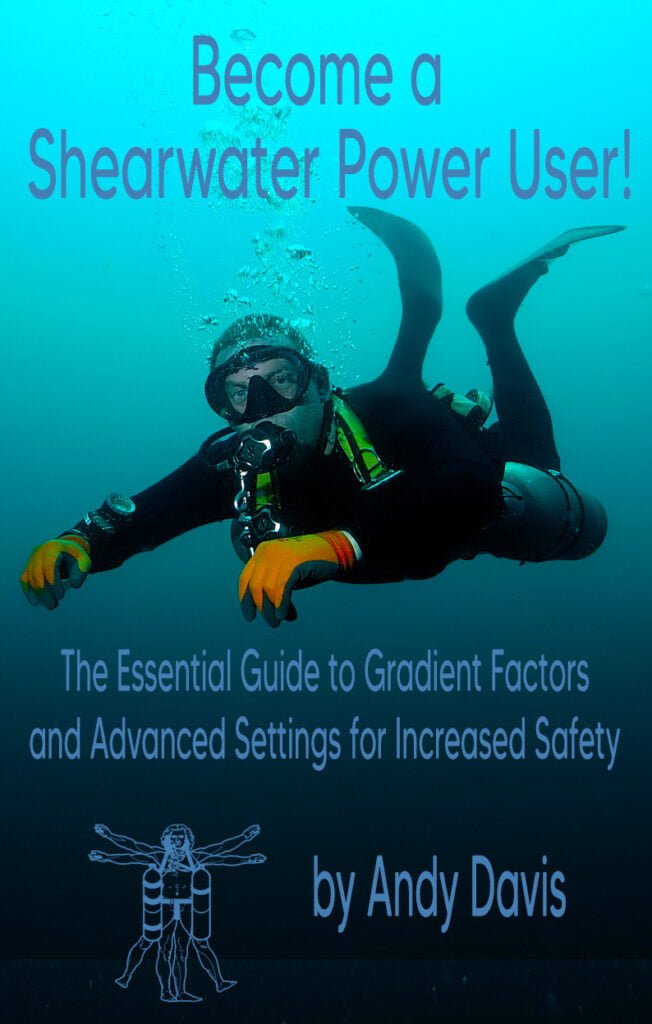


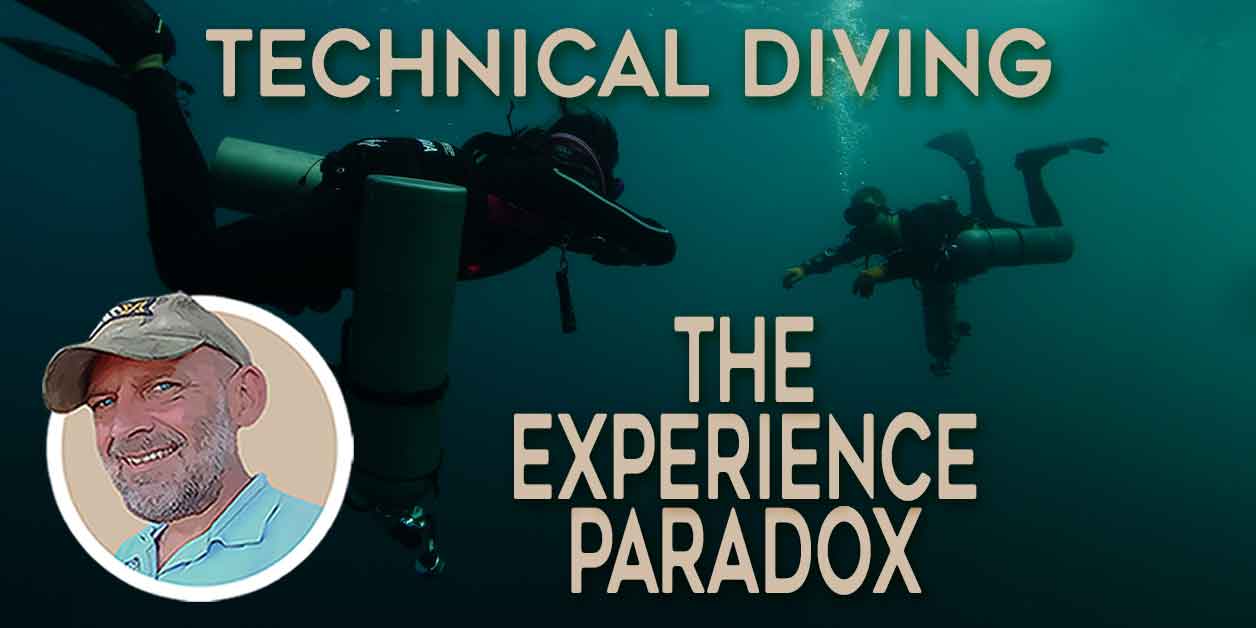
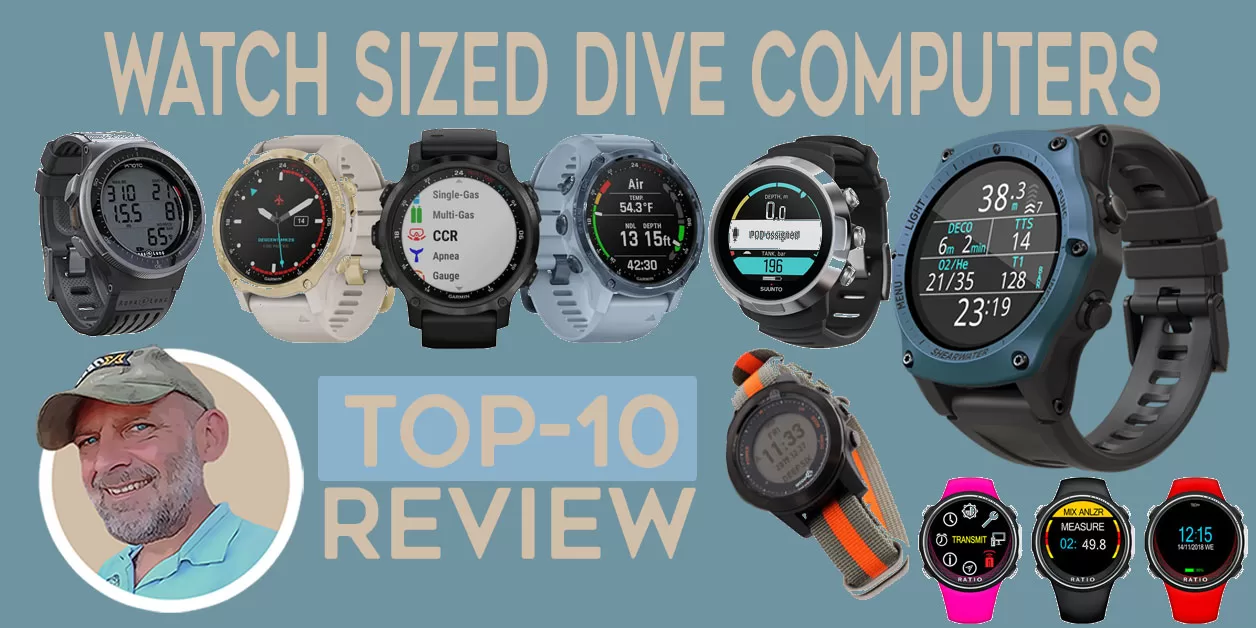


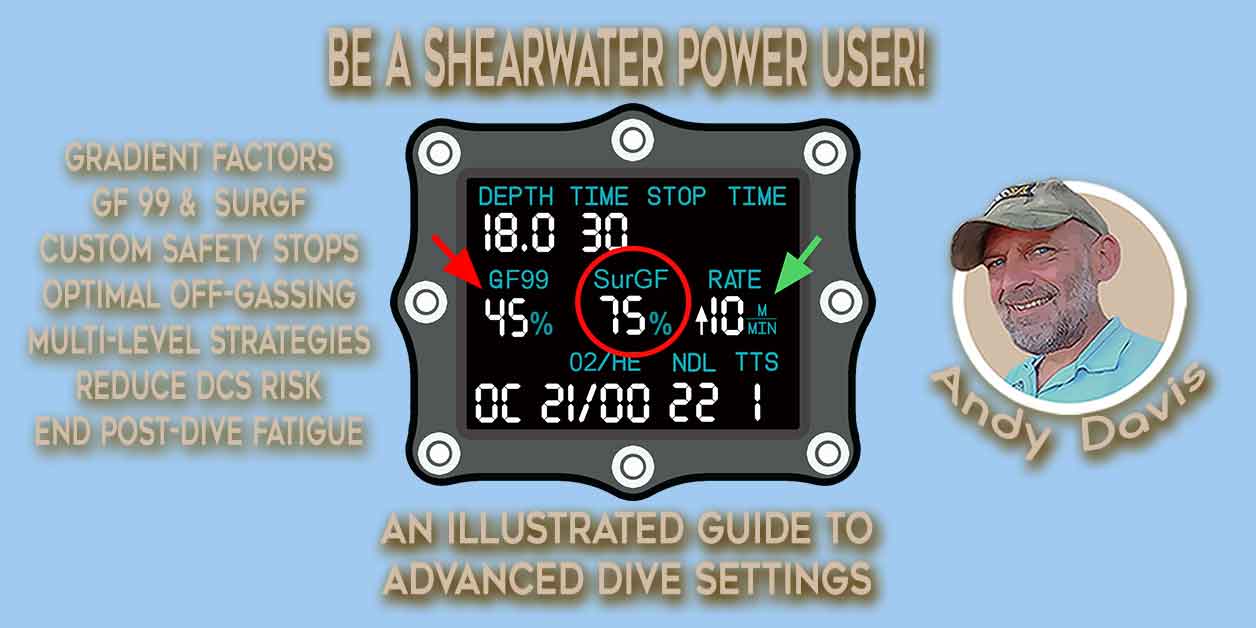

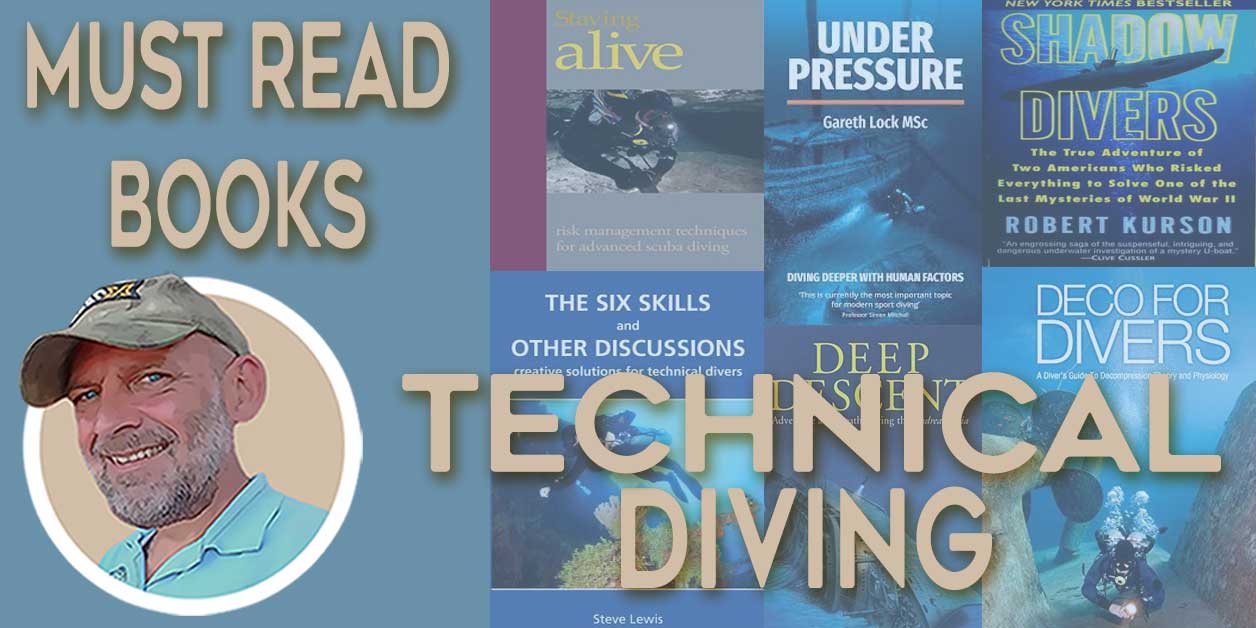
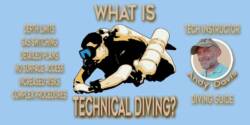
Andy,
A comment on how to use PDIS on the Scubapropro computers (PDIS is not present on the G2 Tek model). There is no need to use it as an actual “stop” since it is optional. However, it does provide some good information. Unlike the traditional “Deep Stop” settings on some computers (1/2 of max depth), PDIS displays the depth at which the leading compartments switch from ongassing to offgassing (the two fastest compartments are not used in this determination). No need to actually stop, but having that ongassing/offgassing depth information available is a nice feature. Not quite the full functionality that GF99 provides, but nice information to have none the less.
Hi Brian, I wrote the bulk of that article early in the new year; I wasn’t seeing information about the Tek version back then. It’s a ‘living’ article, so I’ll get the G2 section updated with the best possible information. Thanks for the heads up.
Andy, interesting that you evaluate the Scubapro G2 in your updated 2023 review rather than the Scubapro G2 Tek when looking at technical diving computers. The G2 Tek uses ZHL-16 GF instead of the ZHL-16 ADT MB PMG and has been out since Fall of 2022. Certainly should have been on a 2023 list. I am not saying it is better than the others, but I have used the G2 Tek for OC and CCR dives as a secondary/backup computer and I would recommend the G2 Tek over the TDC-3 if you are not diving VPM. There are issues with the TDC-3 not clearing stops when diving ZHL-16 with GF.
The Scubapro G2 Tek still has a SOS mode, but to get to that point, the computer is running pure Buhlman (100/100) and the diver still missed a stop for more than 3 minutes. If you exceed your GF stop by 5 feet, the computer will adjust the GF to the next possible settings for that depth. It increase GF Low in steps of 10 and GF High in steps of 5. I think it is an interesting take to adjust the GF versus calculating extended next stops using the same GF settings. I prefer my Shearwater computers, but the G2 Tek is an improvement for technical diving compared to the original G2.
Thanks Chris. I have updated the article to reflect that.
Just FYI Andy, the Ratio ix3m 2 Tech+ does offer ZHL-16C